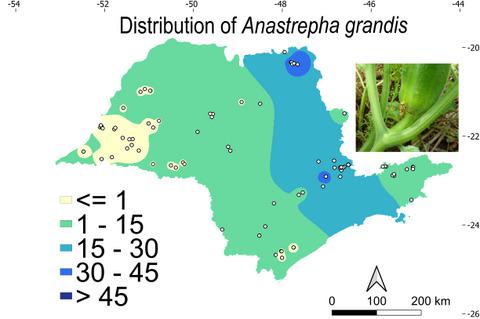当前位置:
X-MOL 学术
›
Entomol. Exp. Appl.
›
论文详情
Our official English website, www.x-mol.net, welcomes your
feedback! (Note: you will need to create a separate account there.)
Climatic and edaphic characteristics constrain the distribution of the quarantine pest Anastrepha grandis
Entomologia Experimentalis et Applicata ( IF 1.4 ) Pub Date : 2021-05-02 , DOI: 10.1111/eea.13065 Walter Mesquita Filho 1 , Miguel Francisco Souza‐Filho 2 , Adalton Raga 2 , André Stocco Oliveira 2 , Aparecida Marques Almeida 3 , Maria José De Marchi Garcia 3 , Joaquim Adelino Azevedo‐Filho 4 , Marcelo Francisco Arantes Pereira 5 , Sônia Maria Nalesso Marangoni Montes 6 , Marcos Doniseti Michelotto 7 , Adriano Gomes Garcia 1 , Wesley Augusto Conde Godoy 1 , Roberto Antonio Zucchi 1
Entomologia Experimentalis et Applicata ( IF 1.4 ) Pub Date : 2021-05-02 , DOI: 10.1111/eea.13065 Walter Mesquita Filho 1 , Miguel Francisco Souza‐Filho 2 , Adalton Raga 2 , André Stocco Oliveira 2 , Aparecida Marques Almeida 3 , Maria José De Marchi Garcia 3 , Joaquim Adelino Azevedo‐Filho 4 , Marcelo Francisco Arantes Pereira 5 , Sônia Maria Nalesso Marangoni Montes 6 , Marcos Doniseti Michelotto 7 , Adriano Gomes Garcia 1 , Wesley Augusto Conde Godoy 1 , Roberto Antonio Zucchi 1
Affiliation

|
The South American cucurbit fruit fly, Anastrepha grandis (Macquart) (Diptera: Tephritidae), is an economically important pest of cucurbits and is classified as a quarantine species in many countries. In Brazil, A. grandis has a limited distribution; it is absent from northern and northeastern Brazil and distributed discontinuously in other parts of the country. To indirectly evaluate the influence of climatic and edaphic variables on the occurrence of A. grandis, we used data based on 4 years of cucurbit fruit collections from all mesoregions of the state of São Paulo. Our results show evidence that A. grandis is constrained by a minimum air temperature above 12 °C, low (<20 °C) and high (>29 °C) maximum air temperature, and by low rainfall and relative humidity, occurring at altitudes from 520 to 780 m. More importantly, A. grandis was not collected in central to western São Paulo, where sandy soil and low soil water availability predominate and the climate is hot and dry. Our findings suggest that soil texture and moisture may be limiting factors for pupal survivorship of A. grandis, and consequently edaphic characteristics should be taken into account in studies on its geographical distribution. Based on our results, central to western São Paulo state can potentially be classified as an area of low pest prevalence. Moreover, in countries where cucurbit species are cultivated in such conditions, it is not likely that A. grandis could become established.
中文翻译:

气候和土壤特性限制了检疫性有害生物大按实蝇的分布
在南美瓜实蝇,实蝇桉(Macquart)(双翅目:实蝇科),是葫芦的一种重要的经济害虫,并归类为许多国家的检疫物种。在巴西,A. grandis分布有限;它在巴西北部和东北部不存在,在该国其他地区不连续分布。为了间接评估气候和土壤变量对A. grandis发生的影响,我们使用了基于圣保罗州所有中间区域 4 年葫芦果实收集的数据。我们的结果表明有证据表明A. grandis受最低气温高于 12 °C、最低气温 (<20 °C) 和最高气温 (>29 °C) 以及降雨量和相对湿度低的限制,发生在海拔 520 至 780 m 之间。更重要的是,A. grandis没有在圣保罗中西部采集,那里以沙质土壤和低土壤水分供应为主,气候炎热干燥。我们的研究结果表明土壤质地和水分可能是A. grandis蛹存活的限制因素,因此在研究其地理分布时应考虑土壤特征。根据我们的结果,圣保罗州中部至西部可能被归类为虫害低流行地区。此外,在这种条件下栽培葫芦科植物的国家,A. grandis不太可能定殖。
更新日期:2021-06-09
中文翻译:

气候和土壤特性限制了检疫性有害生物大按实蝇的分布
在南美瓜实蝇,实蝇桉(Macquart)(双翅目:实蝇科),是葫芦的一种重要的经济害虫,并归类为许多国家的检疫物种。在巴西,A. grandis分布有限;它在巴西北部和东北部不存在,在该国其他地区不连续分布。为了间接评估气候和土壤变量对A. grandis发生的影响,我们使用了基于圣保罗州所有中间区域 4 年葫芦果实收集的数据。我们的结果表明有证据表明A. grandis受最低气温高于 12 °C、最低气温 (<20 °C) 和最高气温 (>29 °C) 以及降雨量和相对湿度低的限制,发生在海拔 520 至 780 m 之间。更重要的是,A. grandis没有在圣保罗中西部采集,那里以沙质土壤和低土壤水分供应为主,气候炎热干燥。我们的研究结果表明土壤质地和水分可能是A. grandis蛹存活的限制因素,因此在研究其地理分布时应考虑土壤特征。根据我们的结果,圣保罗州中部至西部可能被归类为虫害低流行地区。此外,在这种条件下栽培葫芦科植物的国家,A. grandis不太可能定殖。











































 京公网安备 11010802027423号
京公网安备 11010802027423号